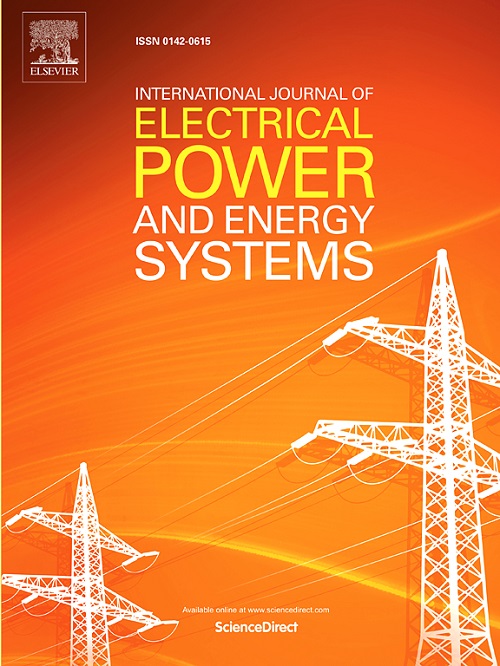考虑非惯性源的复杂多区域互联混合电力系统的频率稳定
IF 5
2区 工程技术
Q1 ENGINEERING, ELECTRICAL & ELECTRONIC
International Journal of Electrical Power & Energy Systems
Pub Date : 2025-05-13
DOI:10.1016/j.ijepes.2025.110730
引用次数: 0
摘要
本文提出了一种新的互联电力系统模型,该模型结合四个实际区域,将传统发电厂与可再生能源(RESs)相结合。该综合系统模型旨在解决此类系统面临的负载频率控制(LFC)挑战。将RESs集成到电力系统中提出了重大挑战,特别是在保持频率稳定性方面。LFC方法利用比例-积分-导数(PID)控制器,通过基于其数学原理的龙格-库塔(RUN)优化器进行精心优化。处理RESs的不确定性和系统的非线性对该控制器提出了很大的挑战。通过分析埃及电力系统(EPS)的频率稳定性来检验基于RUN算法的PID控制器的有效性,该系统与约旦,利比亚和苏丹的邻近电网保持互联。本研究考虑了各种负载情况和系统非线性,以验证算法的有效性。此外,通过将RUN优化器的结果与其他广泛认可的优化技术(如Ant Lion优化器(ALO)和切尔诺贝利灾难优化器(CDO))进行对比,验证了RUN优化器的优越性能。此外,本文还对基于RUN优化器的PID控制器进行了评价,对比了采用蛾群算法(MSA)设计EPS中基于PID控制器的LFC的文献。MATLAB环境下的仿真结果验证了基于RUN算法的PID控制器的有效性和鲁棒性。基于运行的PID控制器优于其他使用文献算法优化的PID控制器(例如ALO, CDO和MSA),在各种突发事件(包括负载变化,RES不确定性和系统非线性)中实现了卓越的性能。与文献中的控制器相比,结果突出了所提出控制器的有效性,将最大超调提高了约20%,将最小欠调降低了约30%。因此,系统达到稳态条件大约快了15秒。最后,利用物理仿真的精度和数值仿真的灵活性,利用OPA-RT平台在实时环境中验证并实现了基于RUN算法的PID控制器。本文章由计算机程序翻译,如有差异,请以英文原文为准。
Frequency stabilization of a sophisticated multi-area interconnected hybrid power system considering non-inertia sources
This study introduces a novel interconnected power system model, which combines four real areas, integrating conventional power plants with renewable energy sources (RESs). This comprehensive system model aims to address the load frequency control (LFC) challenges that such systems face. Where the integration of RESs into power systems poses significant challenges, particularly in maintaining frequency stability. The LFC approach utilizes a proportional-integral-derivative (PID) controller, meticulously optimized through the Runge-Kutta (RUN) optimizer based on its mathematical principles. Dealing with the uncertainties of RESs and system nonlinearities poses a significant challenge for this controller. The efficacy of the proposed PID controller based on the RUN algorithm is examined by analyzing the frequency stability of the Egyptian power system (EPS), which stays interconnected with neighboring grids in Jordan, Libya, and Sudan. This study accounts for various loading scenarios and system nonlinearities to validate the algorithm’s effectiveness. Furthermore, the superior performance of the RUN optimizer is verified by contrasting its results with other widely recognized optimization techniques, such as the Ant Lion optimizer (ALO) and Chernobyl disaster optimizer (CDO). Additionally, the PID controller based on the RUN optimizer is also evaluated against literature that employed a moth swarm algorithm (MSA) to design the PID controller-based LFC in the EPS. Simulation results in the MATLAB environment demonstrate the effectiveness and robustness of the proposed PID controller based on the RUN algorithm. The RUN-based PID controller outperforms other PID controllers optimized using algorithms from the literature (e.g., ALO, CDO, and MSA), achieving superior performance across various contingencies, including load variations, RES uncertainties, and system nonlinearities. The results highlight the effectiveness of the proposed controller compared to those in the literature, improving the maximum overshoot by approximately 20% and reducing the minimum undershoot by about 30%. As a result, the system reaches steady-state conditions roughly 15 s faster. Finally, to leverage the precision of physical simulation and the flexibility of numerical simulation, the proposed PID controller, based on the RUN algorithm, is validated and implemented in a real-time environment using the OPA-RT platform.
求助全文
通过发布文献求助,成功后即可免费获取论文全文。
去求助
来源期刊
CiteScore
12.10
自引率
17.30%
发文量
1022
审稿时长
51 days
期刊介绍:
The journal covers theoretical developments in electrical power and energy systems and their applications. The coverage embraces: generation and network planning; reliability; long and short term operation; expert systems; neural networks; object oriented systems; system control centres; database and information systems; stock and parameter estimation; system security and adequacy; network theory, modelling and computation; small and large system dynamics; dynamic model identification; on-line control including load and switching control; protection; distribution systems; energy economics; impact of non-conventional systems; and man-machine interfaces.
As well as original research papers, the journal publishes short contributions, book reviews and conference reports. All papers are peer-reviewed by at least two referees.

 求助内容:
求助内容: 应助结果提醒方式:
应助结果提醒方式:


